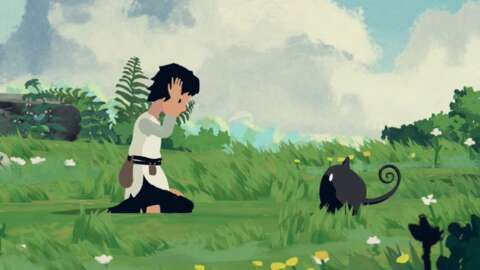Planet of Lana begins in the quaint fishing village its titular protagonist calls home. As you chase after your older sister, stumbling at times–which elicits laughter from big sis–you’re afforded time to get to grips with the game’s 2D platforming, jumping and climbing over the wooden docks, platforms, and rooftops that make up this small but dense town. After passing through a bustling market where people are selling strawberries and freshly-caught fish, you sneak past a chef chopping up vegetables amid plumes of steam before passing by empty boats moored in the crystal-clear waters the town is built upon. It’s a moment of serenity that could be mistaken for a rural location on Earth, were it not for the all-encompassing moon dominating the sky. As you gradually make your way out of town and into the verdant hilltops nearby, this fleeting tranquility is shattered by the ominous sight of dozens of drop pods tumbling into the planet’s atmosphere.
Darting back through the village in the opposite direction is a harrowing experience, as an apocalyptic army of tinted-black robots begins rounding up any signs of life. The peaceful sound of waves crashing against the shore is violently replaced by people screaming and the unnatural bleeps of faceless colonizers, establishing a sharp contrast between tranquility and chaos. With her entire world turned upside down, Lana sets out on a seemingly impossible quest to rescue her captured sister and village, taking you on an enchanting four-hour adventure that’s inspired by cinematic puzzle-adventure games like Another World, Inside, and the Oddworld series. You can see bits and pieces of each of these games reflected in Planet of Lana’s gameplay, from its deliberate platforming to its logic and physics-based puzzle-solving. Yet it’s the animated movies of Studio Ghibli that serve as the primary influence for Swedish developer Wishfully–something that’s apparent right from the game’s first few seconds.
Opening up on a shot of the daytime sky, the vivid hand-painted art style immediately pulls you in and evokes movies such as Spirited Away and My Neighbor Totoro without trying to replicate their exact style. Objects closer to the screen are coated in finer detail, for instance, while the vibrant backgrounds use broader, thicker brush strokes, creating a layered image that makes it feel like you’re inside an interactive painting. Just glancing at screenshots sells the game’s gorgeous aesthetic, but it looks equally stunning in motion, with trees swaying in the breeze, critters scurrying out of sight as you traverse through woodland, and ancient structures whirring to life after being dormant for decades–the world feels alive. The sense of scale is noteworthy, too, not just from a visual standpoint, but because of the way it gives perspective to the scope of Lana’s task. The giant robot mothership that initially looms in the distance gradually consumes more and more of the horizon as you inch closer to its foreboding structure, providing a visible landmark for your journey’s progress.
